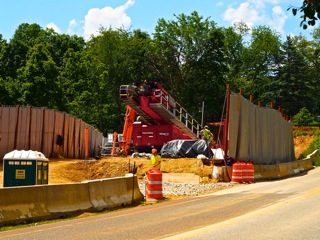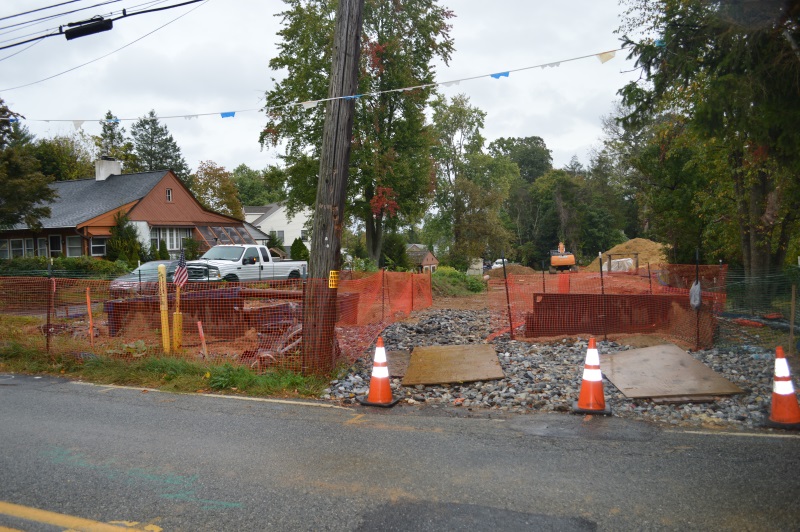Since my update earlier this year several events have transpired which impact this large construction program.
 Mariner East 1(ME 1) was built in 1931 to transport petroleum products from Marcus Hook to Western Pennsylvania. It was built at a time when Delaware and Chester Counties were sparsely populated. It is 300 miles long and 8 inches in diameter. In 2002 the Pennsylvania Utility Commission(PUC) determined that this was a public utility and issued a Certificate of Public Convenience to Sunoco Logistics, its present owner. In 2015 Sunoco "repurposed" ME 1 by reversing flow to transport 70,000 barrels of natural gas liquids(NGLs) from the Marcellus Shale region to their Marcus Hook facility for export to Europe for the manufacture primarily of plastics, antifreeze, and detergents. NGLs consist of propane, butane, and ethane which are odorless, heavier than air, highly flammable, and transported under extremely high pressure in liquid form. When they escape, they revert back to their gaseous state, and being heavier than air, they "hug" the ground and do not dissipate into the atmosphere like natural gas. Any ignition source – like starting a car, using a cellphone, or turning on a light – can trigger a massive explosion.
Mariner East 1(ME 1) was built in 1931 to transport petroleum products from Marcus Hook to Western Pennsylvania. It was built at a time when Delaware and Chester Counties were sparsely populated. It is 300 miles long and 8 inches in diameter. In 2002 the Pennsylvania Utility Commission(PUC) determined that this was a public utility and issued a Certificate of Public Convenience to Sunoco Logistics, its present owner. In 2015 Sunoco "repurposed" ME 1 by reversing flow to transport 70,000 barrels of natural gas liquids(NGLs) from the Marcellus Shale region to their Marcus Hook facility for export to Europe for the manufacture primarily of plastics, antifreeze, and detergents. NGLs consist of propane, butane, and ethane which are odorless, heavier than air, highly flammable, and transported under extremely high pressure in liquid form. When they escape, they revert back to their gaseous state, and being heavier than air, they "hug" the ground and do not dissipate into the atmosphere like natural gas. Any ignition source – like starting a car, using a cellphone, or turning on a light – can trigger a massive explosion.
In December 2013 Sunoco Logistics announced that they would be constructing Mariner East 2 (ME 2) also to transport NGLs from the Marcellus and Utica shale regions to Marcus Hook. In 2014 the PUC determined that the NGLs were petroleum products and Sunoco had the authority to transport them from the shale regions to Marcus Hook. Sunoco anticipated completing the ME 2 project by the end of 2016. ME2 would actually consist of two pipelines, one 20"in diameter and another 16" in diameter to mostly follow the existing right-of-way of ME1. At 350 miles long, it would cost about 2.5 billion dollars. If all three ME pipelines become operational, they would transport 670,00 barrels of NGLs each day.
The initial opposition to Sunoco's claim to public utility status (which gave them the power of eminent domain) was not successful. The next phase was to oppose Sunoco's permit applications to the Pennsylvania Department of Environmental Protection (DEP) which consisted of Chapter 102 (Erosion and Sedimentation Control) and Chapter 105 (Water-Obstruction & Encroachment). The DEP initially conducted public hearings throughout the state and solicited written comments regarding these applications. The Clean Air Council (CAC), Mountain Watershed Association (MWA), Delaware Riverkeeper Network (DRK), and the Sierra Club funded technical reviews of these applications by experts who determined they were deficient.
In February of this year, the DEP under pressure from the Governor's office approved Sunoco’s third revision without conducting additional public hearings or soliciting public comments. The CAC, MWA, and DRK sought to halt construction because of the flawed permit applications but were denied by the Environmental Hearing Board after a three day hearing last March. Things looked bleak for those opposing the project despite these astonishing facts: 1.The public utility status of the Mariner East project was questionable; 2. The DEP had hastily approved technically deficient permit applications; and 3. The route of these NGL pipelines through densely populated Chester and Delaware Counties was unprecedented.
Sunoco has the worst safety record in the US among pipeline operators, so the shortcuts they have taken thus far have been no surprise. But their haste to complete this project has created an opportunity for the opposition. For example, the DEP had warned Sunoco that they had not identified most of the private water wells along the route of ME 2 where horizontal directional drilling (HDD) was to be utilized. This drilling method bores holes between two locations and the pipelines are pulled through those holes. But this drilling technique can be hazardous in areas with Karst topography typical of parts of Chester and Delaware counties where HDD is being used. Karst topography is formed by the dissolution of soluble rocks like limestone, dolomite, and gypsum. Characterized by underground drainage systems with sink holes and fissures, Karst topography can produce “inadvertent returns” (IR) which occur when drilling fluid (a mixture of water and bentonite clay used to lubricate the drill bit) spills out of the drilled hole. This has the potential to contaminate aquifers and therefore, drinking wells, something which recently occurred in Chester County.
The release in June of drilling mud from the HDD process contaminated several private wells in West Whiteland township in Chester County. The company had to offer hotel accommodations to residents whose water was affected and then provide them with access to public water. But despite acknowledging their error, they continued drilling after a brief stoppage. In response to this, State Senator Dinniman sent a letter to the Secretary of PA DEP stating that Sunoco had submitted bad data in their Chapter 105 permit applications by not identifying private wells in areas planned for HDD and called for a halt in construction.
 On July 25th the CAC, MWA, and DRK requested that the Environmental Hearing Board (EHB) temporarily halt all Sunoco drilling operations along the pipeline. These groups documented at least 90 drilling fluid spills which resulted in damage to water supplies in at least five locations. The EHB granted this request and a hearing was scheduled. This was later cancelled after a settlement was reached requiring Sunoco to use experts to evaluate and improve drilling plans at over 60 locations (which was later reduced to 41) prior to starting or restarting drilling. The settlement also stipulated that they expand the identification and free testing of private water supplies. Also, in many sites Sunoco was required to conduct geothermal evaluations to include field drilling and sampling, seismic surveys, ground penetrating radar, electromagnetic surveys, and electrical resistivity tomography. Upon reevaluation of each HDD site, Sunoco had a provide a report signed and sealed by a professional geologist detailing all actions taken to reduce or eliminate inadvertent releases of HDD drilling fluids. These reports were to be sent to the DEP which had 21 days to approve or decline them. In addition, landowners along the route of HDD were given additional protection for their water supplies.
On July 25th the CAC, MWA, and DRK requested that the Environmental Hearing Board (EHB) temporarily halt all Sunoco drilling operations along the pipeline. These groups documented at least 90 drilling fluid spills which resulted in damage to water supplies in at least five locations. The EHB granted this request and a hearing was scheduled. This was later cancelled after a settlement was reached requiring Sunoco to use experts to evaluate and improve drilling plans at over 60 locations (which was later reduced to 41) prior to starting or restarting drilling. The settlement also stipulated that they expand the identification and free testing of private water supplies. Also, in many sites Sunoco was required to conduct geothermal evaluations to include field drilling and sampling, seismic surveys, ground penetrating radar, electromagnetic surveys, and electrical resistivity tomography. Upon reevaluation of each HDD site, Sunoco had a provide a report signed and sealed by a professional geologist detailing all actions taken to reduce or eliminate inadvertent releases of HDD drilling fluids. These reports were to be sent to the DEP which had 21 days to approve or decline them. In addition, landowners along the route of HDD were given additional protection for their water supplies.
The CEO of Energy Transfer Partners, the parent organization of Sunoco Logistics had told their shareholders that ME 2 would be functioning by the end of the third quarter of 2017. This date will have to be postponed for quite awhile and maybe indefinitely due to various pending lawsuits. Some of these are:
- The Clean Air Council is suing Sunoco, challenging their granting of eminent domain, arguing that they are not a public utility. This case will be heard in Federal Court in Philadelphia in early 2018.
- The CAC, MWA, and DRK are appealing the DEP's approval of Sunoco's Chapter 102 and 105 permit applications because they are technically flawed.
- Three residents in Middletown township are requesting that the courts direct their township to enforce setback ordinances which they had previously ignored by greenlighting this project.
- Two residents in West Goshen township supported by the DRK are requesting that the courts direct their township to enforce the ordinance adopted in 2014 that requires that hazardous volatile liquid pipelines be constructed only in Industrial Zoning Districts and not in residential areas as Sunoco plans to do. This case will be heard in Philadelphia sometime in October or early November.
- A temporary injunction has been issued by an administrative law judge preventing Sunoco from building an above-ground safety valve on the east side of route 202 rather than on the west side as per a 2015 settlement with the West Goshen township. The
PUC is scheduled to hear this case this month.
As this litigation winds through the courts, safety groups in several townships along the route of ME 2 have formed to improve pipeline safety and to oppose future pipeline construction. Many of these have now formed an umbrella organization called Del-Chesco United for Pipeline Safety.
Bernie Greenberg, Chairman SPG Sierra Pipeline Committee.